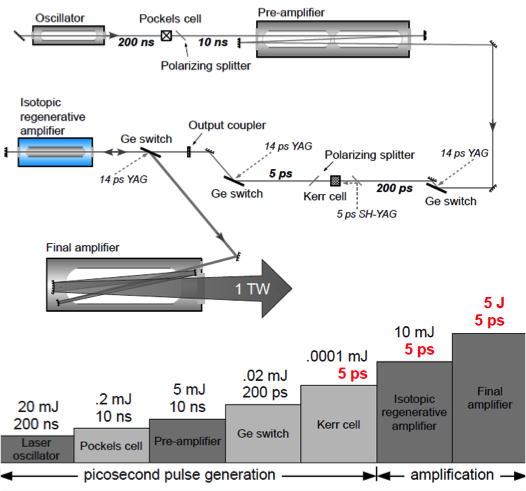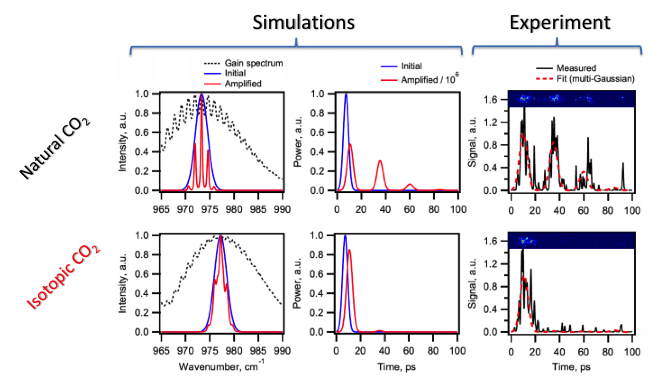- Home
- Capabilities
- Science Highlights
- Operations
- Publications
-
ES&H
- Experiment Start-up
- Laser Safety
Collider-Accelerator Dept.
- C-AD ES&H Resources
- Staff
- Users' Place
- Apply for Access
Use of Isotopic Mix of CO2 Laser Amplifier for TW Picosecond Pulses
The design of the ATF’s terawatt CO2 laser is based on a modified scheme for a master oscillator power amplifier (MOPA). The rotational vibrational structure of the spectrum of the laser transition in a conventional, atmospheric pressure CO2 laser does not support using a mode locking technique for generating pulses shorter than ~1 ns. Thus, in the ATF’s system, an initial few picosecond pulse is produced by cutting a “thin slice” out of the hundred nanosecond output of a conventional CO2 oscillator via a series of fast optical switchers controlled by a short pulse solid state laser. We use semiconductor plasma switches and a Kerr cell to slice the pulse . Then, a series of high pressure amplifiers boost the pulse energy. A small aperture (15 mm) regenerative amplifier, providing ~10,000 amplification, is followed by one with a large aperture (100 mm) that further amplifies the pulse ~1,000 times to multi-Joule energies. CO2 amplifiers are excited by a transverse discharge with UV preionization (regenerative amplifier) and Xray pre-ionization (final amplifier). The detailed layout of the ATF’s CO2 laser system is depicted in Figure 1. The ability to generate a single picosecond pulse is unique to the ATF’s CO2 laser. A common problem in amplifying picosecond 10 µm pulses is the discrete rotational line structure of the gain spectrum of the molecular gas laser amplifier.

Figure 1. Layout and pulse dynamics in the ATF’s CO2 laser system.
Upon amplification, the pulse’s spectrum acquires the corresponding periodic structure. In the time domain (inverse Fourier transform of the spectrum), this results in the pulse splitting into a train with a pulse-to-pulse distance equal to the inverse separation of the spectral lines (18 ps in the P, and 25 ps in the R branches).
The ATF applied a novel approach comprising several elements [1] for eliminating pulse splitting: (1) Operating at an R branch (?=10.3 µm) of a laser transition having a denser line structure than a conventional P branch (?=10.6 µm); (2) using high gas pressure (8-10 atm) in both power amplifiers to reduce spectral modulation due to collisional broadening of the rotational lines; (3) employing isotopic CO2 gas mixture, wherein the 16O atoms are partially substituted by another stable isotope, 18O in the regenerative amplifier; and, (4) utilizing the effect of spectral line broadening in strong laser field for suppressing pulse splitting in the final amplifier.

Figure 2. 5-ps (FWHM) pulse amplification in a natural- (top) and isotopically enriched- (bottom) active media.
Employing an isotopic active media in the regenerative amplifier is the most innovative approach implemented recently in the ATF’s laser system. Figure 2 demonstrates complete suppression of pulse splitting upon amplification.
[1] Polyanskiy, M.N., I.V. Pogorelsky, and V. Yakimenko, Picosecond pulse amplification in isotopic CO2 active medium. Optics Express, 2011. 19(8): p. 7717-25.




